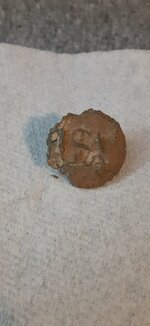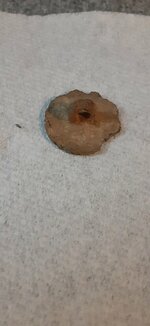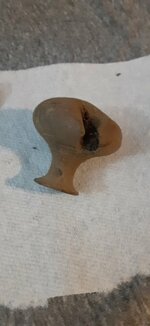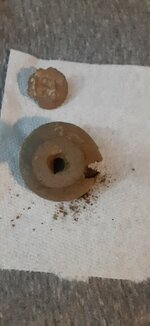I found a 1777 Continental Army, General Service button yesterday. It's not in the greatest of shape, but ones I've seen for sale weren't in much better shape. Totally stoked! Also, I found an old doornob that has a set-screw slot. The head is probably around 2 1/2" in diameter.
You are using an out of date browser. It may not display this or other websites correctly.
You should upgrade or use an alternative browser.
You should upgrade or use an alternative browser.
My oldest find yet...1777 Button
- Thread starter Sorthious
- Start date
EmuDetector
Forum Supporter
Very cool button!
MSCguy
Full Member
That button is an excellent find. Is it pewter? If so, you may want to research how to preserve the button. I'm no expert, but my understanding is pewter will continue to degrade unless steps are taken. Definitely a relic worth preserving.
Congratulations!
Congratulations!
Wolf-Dog
Elite Member
Amazing find! 

cellrdwellr
Elite Member
Pretty sure you are correct, very flaky stuff. I have a few pewter buttons, but none like that. Congrats to you Sorthious!That button is an excellent find. Is it pewter? If so, you may want to research how to preserve the button. I'm no expert, but my understanding is pewter will continue to degrade unless steps are taken. Definitely a relic worth preserving.
Congratulations!
That button is an excellent find. Is it pewter? If so, you may want to research how to preserve the button. I'm no expert, but my understanding is pewter will continue to degrade unless steps are taken. Definitely a relic worth preserving.
Congratulations!
Pretty sure you are correct, very flaky stuff. I have a few pewter buttons, but none like that. Congrats to you Sorthious!
Thanks! Yeah, it's pewter. I'm not sure how to conserve it yet, but, I know with coins you can use olive oil, but I will listen to suggestions to the contrary. I just put it in a small jewelry box for now. I had only lightly brushed it to clean the surface dirt. I didn't use water or anything else. I saw another that sold for $80, but value had been estimated at 2-300.00. It was more complete than mine, but looked less ledgible. Regardless, I don't think I'll be selling it any time soon!
MasonDixonMding
Elite Member
Way to go. That’s a fantastic button. It’s so cool to hold a piece of our history in your hand. I would hit that site very hard. There might be more good stuff there.
Last year I found the same button. I hit this site very hard. And I come up with many other fantastic buttons.
Good luck and congrats!
Last year I found the same button. I hit this site very hard. And I come up with many other fantastic buttons.
Good luck and congrats!
How did you go about preserving it. I'm debating how to handle it now.Way to go. That’s a fantastic button. It’s so cool to hold a piece of our history in your hand. I would hit that site very hard. There might be more good stuff there.
Last year I found the same button. I hit this site very hard. And I come up with many other fantastic buttons.
Good luck and congrats!
hoser
Forum Supporter
Very cool indeed! I hope you find the best way to conserve that beauty.

MasonDixonMding
Elite Member
I lightly cleaned it with a tooth pick and my fingers. Than I put it in a plastic gem jar. It laid in a field for 245 years +/- it should be fine in a plastic case. I wouldn’t want to put something on it only to find out later that it was not the correct thing to do. For me less is more.How did you go about preserving it. I'm debating how to handle it now
It’s a great find! I’m happy for you. Every time I see mine it makes me smile.
I hear ya! Congrats to you as well! I see a lot of people warning about the pewter "drying out" and falling to pieces, then I've seen others who've have pewter buttons for years with no issues. Most suggest using Renaissance Wax to seal the item, other suggest a glue/water mixture, if the item is falling apart, before sealing it. I'll keep an eye on it, and would also like to not do anything that can't be reversed. Thanks for the input!
Princess
Elite Member
- Joined
- Apr 9, 2017
- Messages
- 2,775
That is really an exceptional find - a Continental Army button, dating back to the year after our Declaration of Independence was signed. In a sense, relics like these can help bring the pages of history to life! Way to go, and thanks for posting. 

That is really an exceptional find - a Continental Army button, dating back to the year after our Declaration of Independence was signed. In a sense, relics like these can help bring the pages of history to life! Way to go, and thanks for posting.
Thanks! I've been detecting for about 2years now, and, since I started, I've been setting goals for myself; My first good find was a 1906 Barber Dime, then my goal was something from 1800's. I found an 1811 Capped Bust Dime! So, then my goal was to find a 1700's item; which the Continental Army button filled. Now what?! Where I live I'm not sure how much further back occupation would have been here in Farmville, VA. Anyway, my new goal is pre 1750's, though I don't know if I'll ever achieve that, but it's fun to try!
Lodge Scent
Senior Member
I would not use renwax. You need something that will get into the cracks and pores and bind the loose bits. I have used water/white glue on pewter and it is good. But I prefer hair spray on pewter buttons. I have a USA button that was very flakey on one part of the rim. I used nothing but my wife's hairspray to preserve it. This was at least 10 years ago and it is holding up fine. I gave it another spray a couple of years ago. And unlike renwax, hairspray is water soluable. All you need to do is soak the button in water if you ever want to remove the dried hair spray.
I would not use renwax. You need something that will get into the cracks and pores and bind the loose bits. I have used water/white glue on pewter and it is good. But I prefer hair spray on pewter buttons. I have a USA button that was very flakey on one part of the rim. I used nothing but my wife's hairspray to preserve it. This was at least 10 years ago and it is holding up fine. I gave it another spray a couple of years ago. And unlike renwax, hairspray is water soluable. All you need to do is soak the button in water if you ever want to remove the dried hair spray.
I decided not to mess with it at all. My girlfriend gave me a small jewelry box to store it in, and that will do for now. It looks flaky in spots, but not overly so. If I notice any deterioration I will definitely try the hairspray approach. I worry that there might be other chemicals in the hairspray that might interact with the pewter. Anyway, thanks for the info; it gives me something else to research and, possibly, apply to other items, such as IHP's and other coins.
Lodge Scent
Senior Member
Do what you feel is best Sorthious. But you should do something rather than nothing when it comes to pewter. It may mave deteriorated slowly in the ground but it will dry out and start to crumble fast out of the ground. I've dug at least 100 pewter buttons over the years and they will flake and crumble quickly, especially if they were flakey to begin with. Use the elmers glue with water if you are afraid to use hairspray.
Reelfoot Relics
Elite Member
Wow. nice button
Princess
Elite Member
- Joined
- Apr 9, 2017
- Messages
- 2,775
Wow, you're on a role! I really doubt I'll ever find anything as aged as what you have uncovered. If you do achieve all of your date goals (and that would be fantastic), then you could try setting other types of goals - it wouldn't necessarily have to top your other finds to bring a certain amount of pleasure. You know, choose a certain relic to pursue... such as one which would have personal intrigue (something that particularly fascinates you), or one with local value (something from the area where you grew up), etc. Just a thought.Thanks! I've been detecting for about 2years now, and, since I started, I've been setting goals for myself; My first good find was a 1906 Barber Dime, then my goal was something from 1800's. I found an 1811 Capped Bust Dime! So, then my goal was to find a 1700's item; which the Continental Army button filled. Now what?! Where I live I'm not sure how much further back occupation would have been here in Farmville, VA. Anyway, my new goal is pre 1750's, though I don't know if I'll ever achieve that, but it's fun to try!
Rock Jock
Elite Member
I had an acquaintance who was into fossil and mineral collecting. He located a place in an anoxic brick claybank that would produce beautiful specimens of marcasite forming on fossil wood. The problem with these specimens is that they would disintegrate rather quickly when exposed to atmospheric oxygen. He came upon information about sodium silicate (the stuff you get in those little packets as an anti-humidity desiccant to absorb moisture) and began using it to preserve delicate specimens. If painted on in a thixotropic aqueous solution, it would dry fairly quickly and make a clear, shiny, protective coating. I make mention of it here as a possible protectant for delicate specimens, but I suggest it be tested on less valuable specimens to see how well it applies and functions. You can thin the solution with water. You would most likely have to completely coat the entire specimen. I have found pewter items previously and they can be really flakey and delicate. I haven't had occasion to try sodium silicate solution on them yet, but the pewter stuff wasn't that exciting to me to set me on such a preservation course. It is an option.





